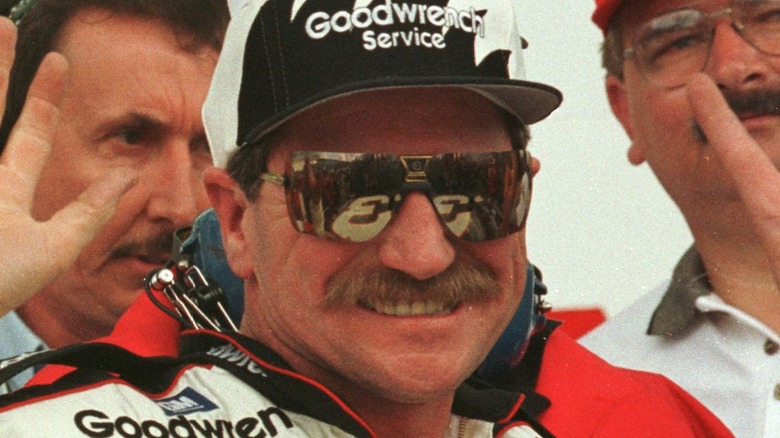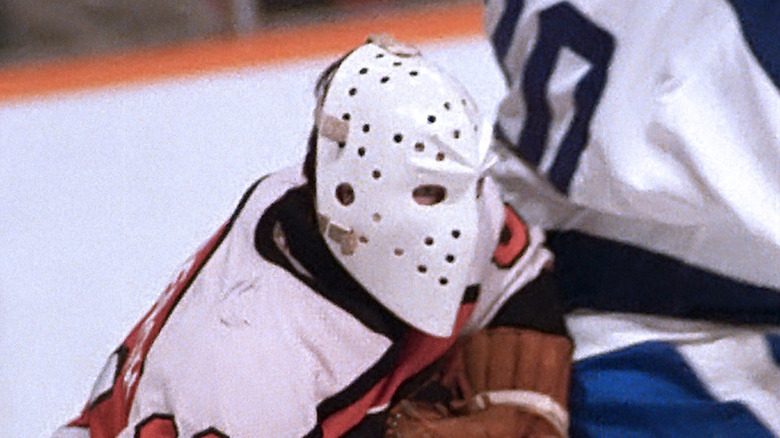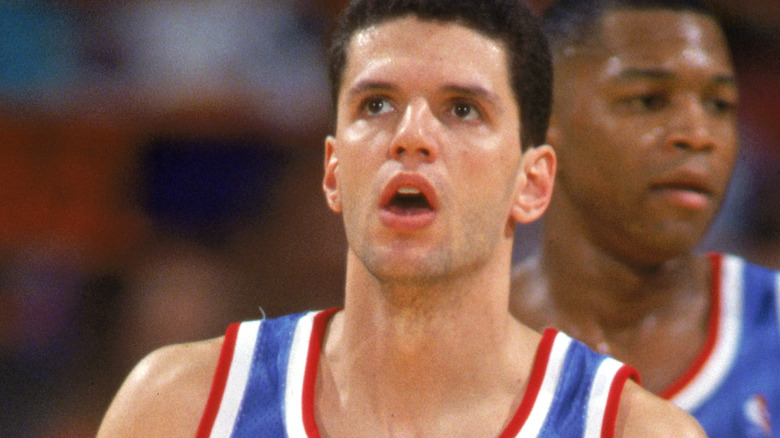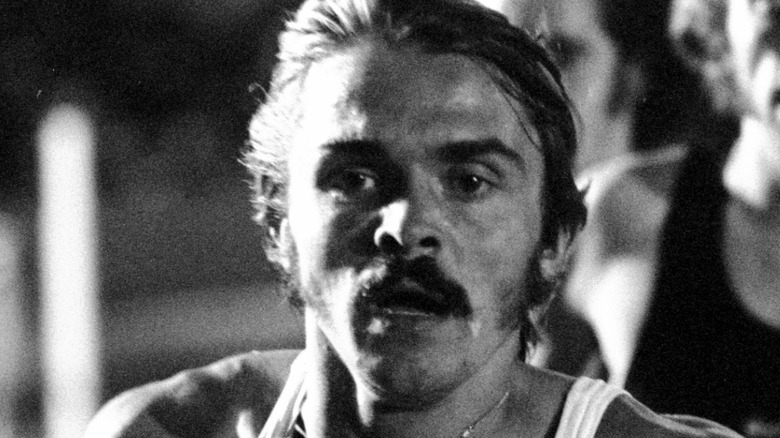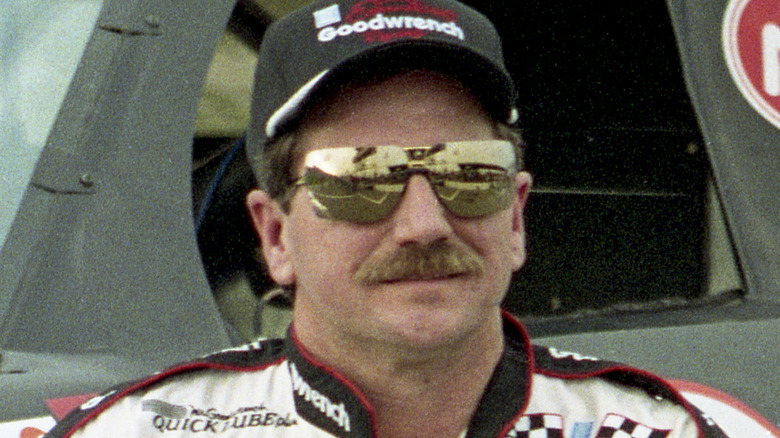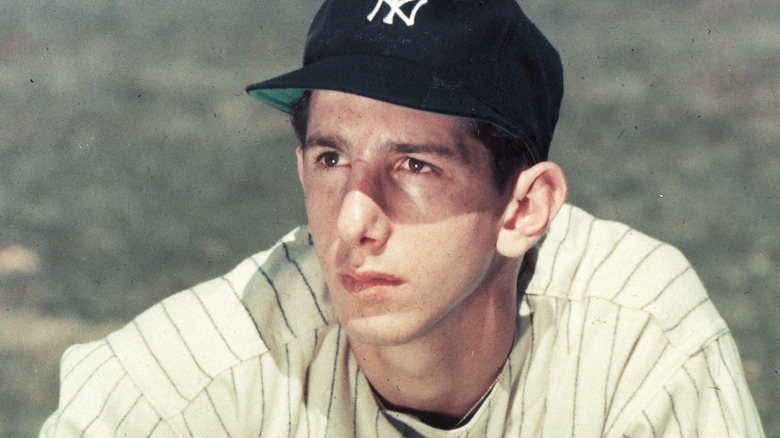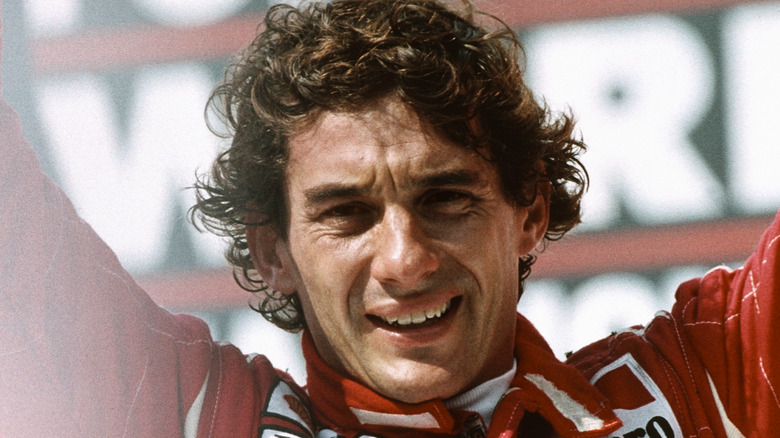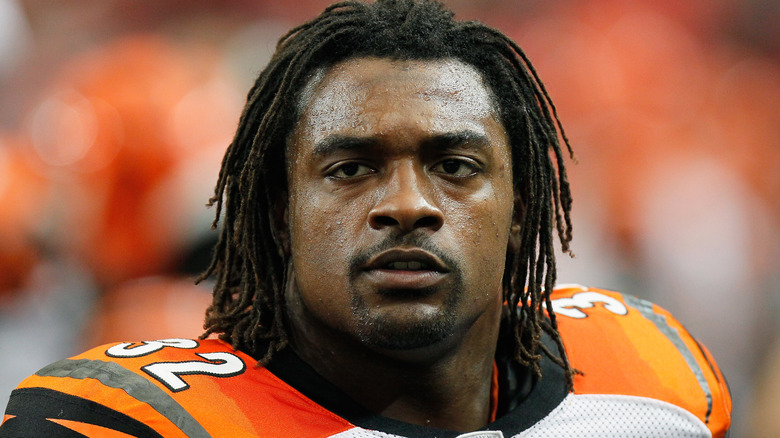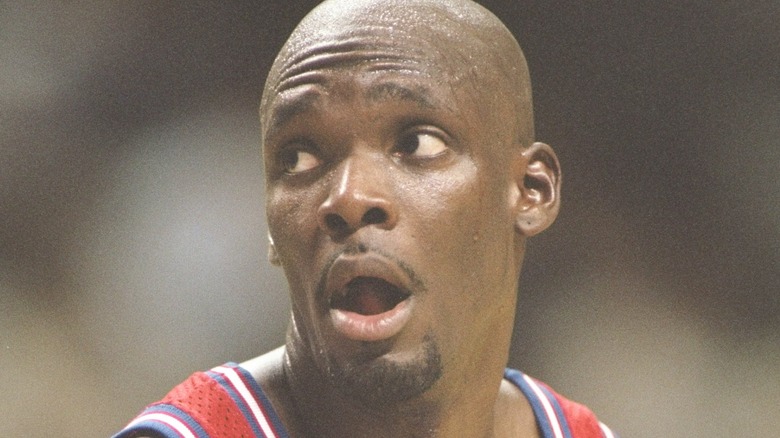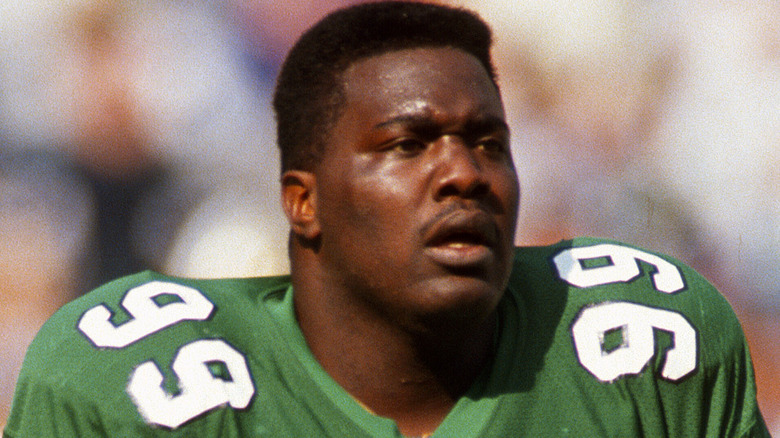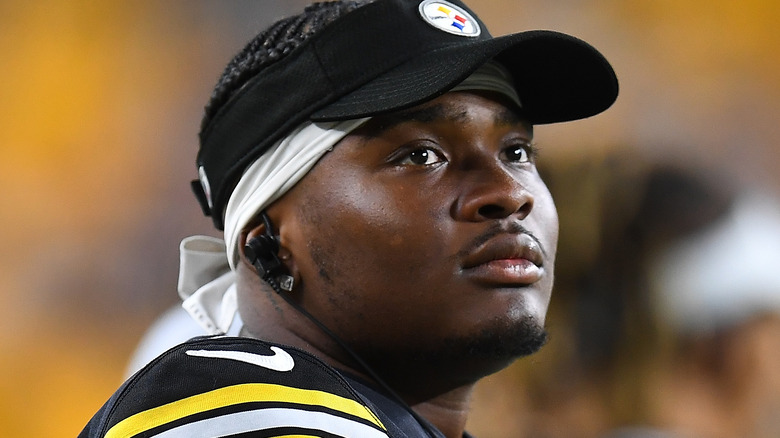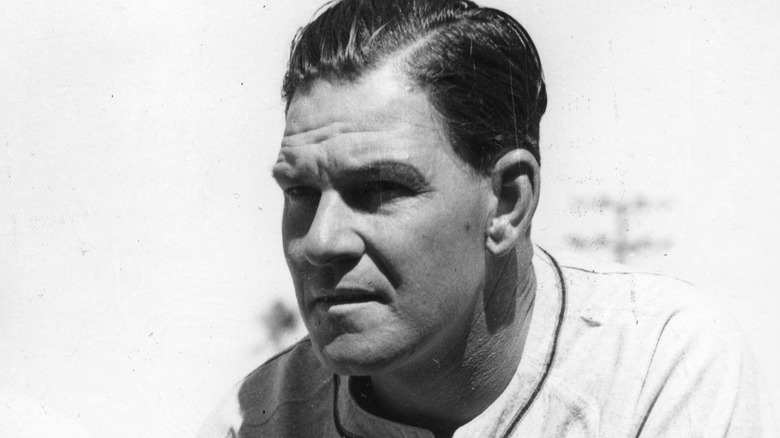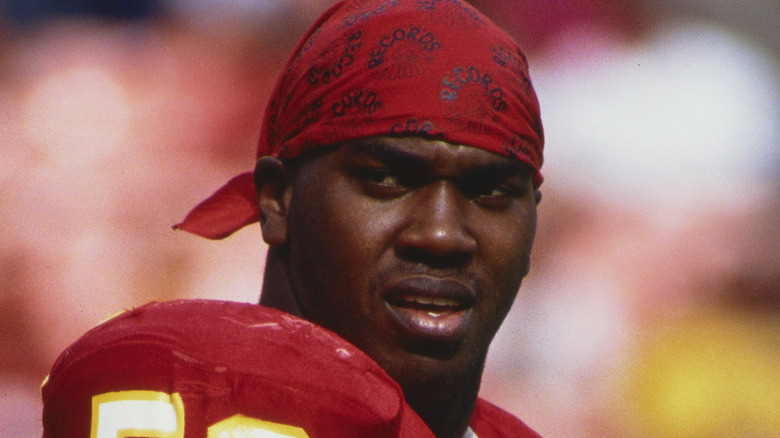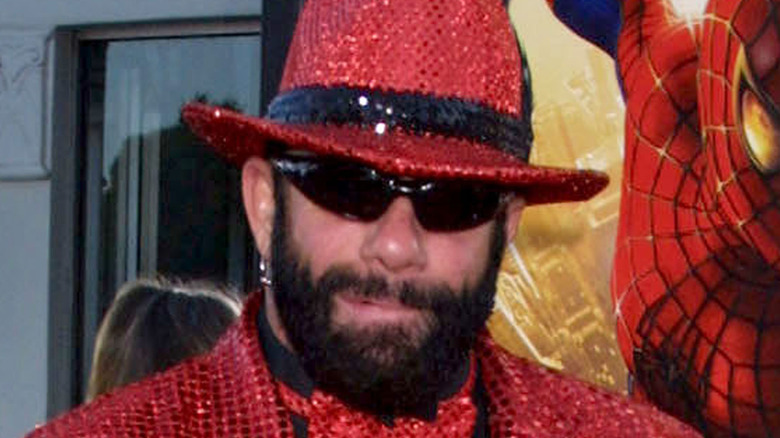Major Athletes Tragically Killed In Car Crashes
Motorized vehicles — cars, vans, trucks, SUVs, motorcycles — are such a part of daily life to so much of the world, and they've been around for so long that it's easy to take them for granted. In the century-plus of the automobile age, cars get people and cargo to where they want to go quickly and safely — well, usually, they do. According to the Insurance Institute for Highway Safety, more than 36,000 people died in vehicular accidents in 2019 alone. It's easy to forget, until a tragic and painful reminder comes along, that automobiles are massive, heavy, pieces of serious machinery that can kill or maim.
Another aspect of modern life: professional athletes, and the tracking and worship thereof. We lionize athletes in our society and put them on such a metaphoric pedestal to celebrate their daring, entertaining, near-physically impossible feats and achievements that we can sometimes fail to realize they are human beings, subject to the same mortal dangers as the rest of us. Here then is where car culture and sports culture meet — the most famous and notable athletes of the past few decades who died unexpectedly and tragically in accidents and crashes involving motorized vehicles.
Pelle Lindbergh
A member of the Swedish national under-20 team, Pelle Lindbergh was drafted by the Philadelphia Flyers in 1979, and after a couple of years in the minor league American Hockey League (where he was named the organization's most valuable player), made his way to hockey's biggest state. A member of the 1982-1983 NHL all-rookie team, Lindbergh was an all-star by 1985, the year he won 40 games and led the league in saves. At the conclusion of that season, Lindbergh received the Vezina Trophy, awarded to the NHL's top goaltender of the year.
Less than six months later, however, Lindbergh was dead. Early one Sunday morning in November 1985, according to the Chicago Tribune, Lindbergh left a bar and drove his Porsche 930 Turbo off of a road in Camden County, New Jersey, not far from Philadelphia, and hit a concrete wall at high speed. Enduring injuries to his spinal cord and brainstem, doctors estimated Lindbergh's chance of recovery at close to zero percent and declared him brain dead. A few days later, Lindbergh was taken off of the respirator keeping him alive, and his organs were donated, per the UPI. Lindbergh was 26.
Drazen Petrovic
According to the NBA, Drazen Petrovic was among the first handful of players born outside of the Americas to make an impact on the league, and help popularize basketball internationally. An inductee of the Naismith Memorial Basketball Hall of Fame, he once scored 112 points in a professional game in league play in his home country of Croatia, played in the 1988 and 1992 Olympics, and led his teams to multiple European championships along with a 4-year career in the NBA with the Portland Trail Blazer and the New Jersey Nets, where he averaged 22.3 points per game.
Mere weeks after he received his first major American pro basketball accolade, named to the all-NBA third team for the 1992-1993 season, Petrovic was dead. According to the Washington Post, on June 7, 1993, Petrovic was riding as a passenger in a vehicle en route to his home in Croatia after leading his national team to a victory in the European Championships in Poland. Outside Frankfurt, Germany, the driver struck a truck and killed all three people inside, including the 28-year-old basketball star.
Terrence Clarke
One of the most promising young basketball prospects of the 2020s, Terrence Clarke seemingly had a bright and productive future ahead. According to WYMT, he was considered one of the top 10 best high school players in the nation, having led his teams to two national prep championship games, and landed a spot on the roster at the storied University of Kentucky, where he scored in double digits in four of his first five games before a leg injury cut his freshman season short. Nevertheless, in March 2021, he declared himself eligible for the NBA Draft.
On the afternoon of April 22, 2021, Clarke was driving in the San Fernando Valley, outside of Los Angeles, when he ran a red light while exceeding the speed limit and not correctly wearing a seat belt, the LAPD told ESPN. Clarke ran into an idling vehicle preparing to make a left turn, careened into a light pole, and then hit a wall. Clarke was immediately sent to Northridge Hospital, where doctors pronounced the athlete dead as a result of injuries suffered in the accident. Clarke was 19. Two months later, the NBA ceremonially selected Clarke during a tribute at its 2022 draft.
Steve Prefontaine
Running — including both cross country and track and field — is a major sport in Oregon, and Steve Prefontaine is one of the most dominant long-distance runners in state history. As a junior and senior at Marshfield High School in Coos Bay, he never lost a cross country race and in track and field, set a record for the quickest 2-mile time in American history. As a member of University of Oregon teams in the early 1970s, he won a total of seven NCAA titles and at one point held every record for races between 2,000 and 10,000 meters, plus the 2 miles and 6 miles. In 1972, 21-year-old Prefontaine was the youngest contestant in the 5,000-meter event at the Summer Olympics, where he finished in fourth place, losing the gold by less than two seconds.
After a 1975 meet at the University of Oregon in Eugene, in which he won the 5,000-meter event, per the New York Times, Prefontaine went to a party held in honor of the six Finnish runners whose arrival in the U.S. he'd facilitated. He dropped off a friend at about 12:30 a.m. and while driving home, and with a blood alcohol content well above Oregon's legal limit, Prefontaine went over a curb, ran into a stone embankment, and flipped over, trapping him underneath the vehicle. Prefontaine, 24 years old, died as a result of the internal injuries suffered in the accident.
Dale Earnhardt
Some athletes inject some much energy and innovation into a sport, one which they utterly dominate for years on end, that they become household names, well-known even to those who don't follow sports. Dale Earnhardt Sr. is that kind of sports celebrity, one of the biggest stars in NASCAR history. Earnhardt Sr., in his highly recognizable "3"-adorned stock car, won 76 major races between 1979 and 2000, including the illustrious Daytona 500 in 1998.
Earnhardt Sr. came close to finishing near the top of the pack for the Daytona 500 again in February 2001, but things would go tragically awry on the final lap, resulting in a fatal auto crash before tens of thousands of fans. As Michael Waltrip and Dale Earnhardt Jr. drove neck and neck in a dramatic battle for first place, a showdown for third place developed between Earnhardt Sr., Sterling Martin, and Ken Schrader. Earnhardt, an aggressive driver known as "The Intimidator," brushed up against Marlin's car, but then lost control and veered off course, striking a wall, and then endured another hit from Schrader, according to ESPN. Earnhardt Sr. didn't quickly emerge from his car, sending medics and a rescue crew into action. Extracted from the totaled race car, Earnhardt was rushed to Halifax Medical Center, where he was pronounced dead at age 49. The cause of death, according to a NASCAR crash report (via Motorsport): Earnhardt Sr. absorbed a sharp impact to the back of his head during the crash.
Billy Martin
Billy Martin's career stats as a Major League Baseball player are modest — 877 hits, .257 average — but he had a couple of breakout seasons and tasted the glory of victory. In 1953, he earned some American League MVP votes and in 1956 he made the All-Star Team, and helped lead the New York Yankees to four straight World Series championships. Martin would remain in the Yankee pinstripes for the more famous second act of his baseball career, acting as the team's manager in tour separate stints across the '70s and '80s, culminating in a World Series victory in 1977.
On Christmas Day 1989, according to the New York Times, Martin was riding as a passenger in a pickup truck driven by his friend, William Reedy. According to witnesses, the vehicle skidded down an icy road outside Binghamton, New York, then careened 300 feet down an embankment before crashing at Martin's driveway. Reedy survived and was arrested on a charge of driving while intoxicated. Martin, who, like Reedy, had not been wearing a seat belt at the time of the accident, died in the crash. He was 61.
Ayrton Senna
The most popular form of auto racing outside of the U.S. is the Formula 1 circuit, a major spectator sport in Europe and Brazil, the home country of Ayrton Senna, among the most accomplished and fan-beloved racers of all time. An active participant for just around 10 years, Senna won 41 big races, including six victories at the monumental Monaco Grand Prix, five of them in consecutive years.
On May 1, 1994, according to Vice, Senna began the San Marino Grand Prix on Italy's Imola circuit in pole position (via Reuters). While piloting his Williams-Renault, Senna improperly negotiated a left corner turn, and as the race car was necessarily traveling at a tremendously high speed, it led the driver to lose control slightly, jerking the car suddenly to the right and sending it almost directly head-on into a track wall. It was later discovered that there were issues with the car's steering column, which Senna had looked into modifying before the Grand Prix. Later that day, Senna died of injuries sustained in the race, primarily multiple skull fractures caused by debris that had pierced his helmet. Senna was 34 years old.
Cedric Benson
Cedric Benson was one of the most productive players in the University of Texas Longhorns football program. According to the New York Times, he started all four years in the early 2000s, rushed for a total of 5,540 yards (11th-best in Division I football all-time), and in 2004 was named the country's best running back in the form of the Doak Walker Award. After being drafted into the NFL in 2005, Benson played eight seasons, which included three superior 1,000 rushing yard seasons but were otherwise marred by injuries and DWI charges.
Benson was back in Austin, where he attended the University of Texas, in August 2019, when he was involved in a fatal vehicular accident. According to Austin police who spoke to TV station KXAN, the driver of a minivan was crossing an intersection when he struck a motorcycle ridden by Benson and a woman unidentified in initial news reports. Both Benson and his passenger were pronounced dead at the scene. The retired football player was 36.
Malik Sealy
An NBA journeyman in the 1990s, Malik Sealy was a reliable backup guard and small forward for multiple teams in the 1990s, including the Indiana Pacers, Los Angeles Clippers, Detroit Pistons, and the Minnesota Timberwolves, averaging a respectable 10.1 points over a career. He turned pro after a stellar college stint with St. John's, where he was a three-time All-Big East Conference selection, a consensus All-America and provider of nearly 20 points per game on average.
After attending a birthday party for his Timberwolves teammate Kevin Garnett in May 2000, Sealy was driving home on Minnesota Highway 100 in the suburbs of Minneapolis at about 4 a.m. when a pickup truck driven by Souksangouane Phengsene collided head-on with the basketball player's Range Rover, according to the Chicago Tribune. Phengsene was later charged with driving while intoxicated and was imprisoned for being directly culpable in the death of the 30-year-old Sealy, according to ESPN.
Jerome Brown
A member of the University of Miami Sports Hall of Fame, Jerome Brown loomed large over his college's football program in the 1980s. The defensive lineman recorded 183 tackles and 21 sacks, and in his senior year was a finalist for multiple player awards and was a consensus All-American. He played in many of the major college bowls of the era — Orange, Fiesta, Sugar — and was drafted with the ninth pick in the 1987 NFL Draft by the Philadelphia Eagles, where he turned out two All-Pro seasons.
In June 1992, per the Washington Post, Brown was exceeding the speed limit when he drove his Corvette out of a car dealership in downtown Brooksville, Florida, and on the incorrect side of the road. He lost control and skidded, sending the vehicle into the air and colliding with a palm tree and then a light pole. The car then flipped over and landed upside-down, killing 27-year-old Brown and his passenger, Augusta Wesley Brown, his 12-year-old nephew.
Dwayne Haskins
A star quarterback at Ohio State — where he set 28 school records and seven Big 10 Conference records in 2018 — Dwayne Haskins came into the NFL in 2019 after being drafted early in the first round by the Washington Commanders. After starting 11 games in two seasons, according to ESPN, Washington released Haskins and he signed with the Pittsburgh Steelers in 2021, serving as a backup to Ben Roethlisberger and a candidate to replace the star QB who retired at the end of the 2021-2022 season.
According to ESPN's Adam Schefter, Haskins died in the early morning hours of April 9, 2022. NPR reported that Haskins, in South Florida for offseason training sessions, was traveling on Interstate 595 in Broward County on foot (later explained that he was walking to get gas for his stalled vehicle) when he was struck and killed by a dump truck when he attempted to cross multiple lanes. Haskins was 24.
Mel Ott
In Major League Baseball's golden era of the first half of the 20th century, Mel Ott was among the national pastime's most reliable sluggers and all-around hitters. A 12-time all-star and World Series champ, Ott's rare accomplishments include 1,860 RBIs, 511 home runs, 2,876 hits, a .304 batting average, and spending the final seven years of his playing career simultaneously managing the New York Giants. That was all more than enough to get him elected into the Baseball Hall of Fame in 1951, his first year of eligibility.
In November 1958, according to the New York Times, Ott was driving in Bay Saint Louis, Mississippi, when his car collided with one driven by local Leslie Curry Sr., who died on the scene. Ott and his wife, Mildred, broke their legs and endured other injuries, according to Jet, and the retired baseball player was transferred to a New Orleans hospital where he succumbed to the effects of the accident a week later. Ott was 49.
Derrick Thomas
A standout in his three years at the University of Alabama, the Kansas City Chiefs selected Derrick Thomas with the fourth overall pick in the 1989 NFL Draft, and it paid off. Kicking off an 11-season career, he was named the Defensive Rookie of the Year by the Associated Press and the Rookie of the Year by UPI, and then led the league in sacks his second year, with 20. All told, Thomas was named to nine Pro Bowl squads, the Pro Football Hall of Fame, and the NFL's all-'90s team.
In January 2000, Thomas was driving himself and two others to the Kansas City airport for a flight to St. Louis for that year's NFC Championship game. On the way, Thomas hit an icy patch of Interstate 435, lost control of the vehicle, and it rolled three times, according to the Washington Post. Thomas, reportedly not wearing a seat belt at the time of the accident, was ejected out of a side window. He survived, was transferred to a hospital in his hometown of Miami, and received spinal stabilization surgery. The accident left Thomas paralyzed. As he recovered from his injuries two weeks after the fact, while hospital staff transferred him from his bed into a wheelchair, Thomas went into cardiac and respiratory arrest and revival efforts failed. Thomas died at the age of 33.
Randy Savage
In the colorful and deeply entertaining professional wrestling scene of the 1980s and '90s, Randy Savage was among the most memorable grapplers to set foot in the ring. Known for his flamboyant and ostentatious costumes — which included cowboy hats, sunglasses, and overly fringed jackets — and gravelly, bellowing voices (which he used to energetically shill Slim Jim snack sticks) the man born Randy Poffo was a really good wrestler. According to EWrestlingNews, Savage won 29 championship-level contests and held 11 titles over a three-decade career, at one point the WWF World Heavyweight Champion and a four-time WCW World Heavyweight Champion.
On May 20, 2011, according to Tampa Bay Online (via CBS News), Savage died in the moments after his Jeep Wrangler suddenly veered across a Florida highway, then moved over a median and struck a tree. However, the violent and grisly car accident isn't what actually killed the pro wrestler. "The crash had nothing to do with his death," William Pellan of the Pinellas-Pasco Medical Examiner's Office said. "He just happened to be driving when he had a cardiovascular event." Officials weren't readily able to determine exactly what heart issue immediately killed Savage while he drove, causing him to crash his vehicle, surmising that it was a heart attack, arrhythmia, or complete failure.
